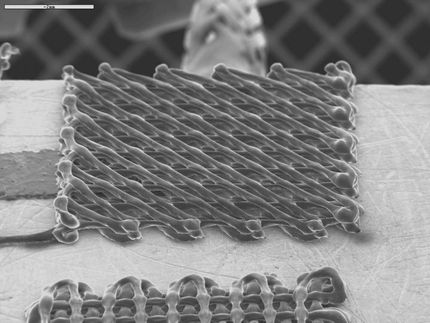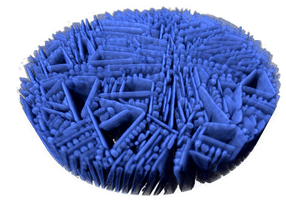Scientists Discover Technique to Control Fluids Using Specially Fabricated Silicon 'Nanograss'
15-Mar-2004
Scientists at Bell Labs have discovered an entirely new method to control the behavior of tiny liquid droplets by applying electrical charges to specially engineered silicon surfaces that resemble blades of grass. The new technique of manipulating fluids has many potential applications, including thermal cooling of integrated circuits for powerful computers, novel photonic components for optical communications, and small, low-cost "lab-on-a-chip" sensor modules.
Details of the technique, which is the result of Bell Labs' research efforts in nanotechnology, are being published in the May 11, 2004, issue of the American Chemical Society's journal, Langmuir.
The advance that made this possible was a breakthrough technique that Bell Labs scientists developed for processing silicon surfaces, so that these surfaces resemble a lawn of evenly cut grass, with individual "blades" only nanometers in size. (A nanometer is a billionth of a meter, roughly one hundred thousand times smaller than the diameter of a human hair).
This new capability to process silicon surfaces to produce "nanograss" lets liquids interact with surfaces in a novel way, thereby providing a way to precisely control their effects. In everyday experience, fluids tend to wet surfaces and stick to them. For example, a raindrop sticks to a car's windshield; when water is spilled, it splatters every which way. The individual blades of the nanograss are so small, however, that liquid droplets sit on top and can be easily maneuvered.
"Physically, this technique reduces the surface area that the droplet feels, and reduces the interaction between the liquid and the substrate by a factor of a hundred to a thousand," said Tom Krupenkin, the Bell Labs scientist who led the research.
Krupenkin and his team coated the nanograss with a non-stick, water-repellent material, and when the droplets are put on the surface, they can move about without wetting it. By applying a small voltage, however, the team could tailor the behavior of droplets, making them sink in and wet the surface as directed. The droplets also respond to a change in temperature, allowing for thermal cooling applications.
"Such behavior may be harnessed to cool computer chips," Krupenkin said. "A droplet could be sent to a hot spot on the chip, where it would sink in and absorb the heat, and then go on its way, avoiding the expense and inefficiency of applying a coolant or a heat sink to an entire chip."
Another application for this technique may be in optical networking. For example, moving a droplet of fluid into a nanograss surface can alter the physical properties of the transmitting medium through which light signals are sent, and this may lead to better methods for optical switching. Novel optical components, such as filters, could be created by moving the fluid into and out of nanograss areas, Krupenkin said.
Most read news
Topics
Other news from the department science

Get the chemical industry in your inbox
From now on, don't miss a thing: Our newsletter for the chemical industry, analytics, lab technology and process engineering brings you up to date every Tuesday and Thursday. The latest industry news, product highlights and innovations - compact and easy to understand in your inbox. Researched by us so you don't have to.




























































